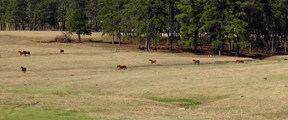Story and Photos by Steven Long
 HOUSTON, (Horseback) – At least some of the horses once belonging to the State of Texas and in custody of the Texas Department of Criminal Justice have been found after being sold at auction. The TDCJ prison horses were located at a facility owned by a former Texas prison inmate and equine kill buyer whose wife confirmed that the horses were the same ones purchased Monday night at a Huntsville, Texas livestock auction.
HOUSTON, (Horseback) – At least some of the horses once belonging to the State of Texas and in custody of the Texas Department of Criminal Justice have been found after being sold at auction. The TDCJ prison horses were located at a facility owned by a former Texas prison inmate and equine kill buyer whose wife confirmed that the horses were the same ones purchased Monday night at a Huntsville, Texas livestock auction.“We are not selling these horses for food,” said TDCJ chief spokeswoman Michelle Lyons. “They were sold at a public auction to the public.”
The horses were sold as culls from the prison system’s extensive livestock program.
“We cannot speak intelligently as to the buyers’ intent,” Lyon’s told Horseback Magazine late Thursday, “but have been informed by the auction house that there were at least 10 different buyers of TDCJ horses.”
Asked if TDCJ was aware of recent concerns raised about the chemicals used to medically treat U.S. horses, Lyons said “Without an extensive review of the horses’ veterinary records, we cannot make assurances regarding what medications they have or have not taken.”
Drugs such as phenylbutazone (Bute), wormers, and a variety of other drugs routinely administered to horses here, possibly including prison horses, are strictly prohibited for use in food animals.

One of the most genetically perfect herds of horses in North America was hit hard by the selloff of 61 animals at a public auction, their most likely destination, a Mexican slaughterhouse notorious for unspeakable cruelty. The herd is genetically and historically important because they have been part of a captive breeding program for more than a century with little outside genetic influence. On the rare occasions other horses have been introduced, they have been foundation pedigreed lines.
The horses were part of a herd of 1,600 owned by the State of Texas and managed by the Texas Department of Criminal Justice in Huntsville, according to Lyons.
The state’s captive herd is subject to the most advanced breeding techniques and is held to exacting standards that are world class. The horses are not grade horses but are beneficiaries of the very best techniques of modern agricultural science. The livestock managers are products of the renowned schools of agriculture at Texas A&M University and the nearby Sam Houston State University. The horses are primarily Quarter Horses with substantial Percheron blood.
The information that the horses had been sold at auction came to Horseback Online Monday night when a confidential source who was at the Huntsville cattle auction called and said that a large number of prison horses had been sold to slaughter and had been loaded on a truck south heading down I-45.
“People who work at the prison are really upset about this,” the man said during a phone call to the magazine’s offices.
The Texas prison system holds “Premium Auctions” of horses only rarely where the public is invited to bid after extensive advertising of the sale. No such ads were placed for the 61 horses sold Monday. They were quietly sent to auction where a large truck was already waiting, according to the source who said the horses sold for about 40 cents a pound.
Lyons confirmed the prison system auctions 90-100 “cull” horses each year from its program.
Livestock auctions are the primary sources of horses sent abroad for food.
The Texas prison system breeds big horses, big enough to hold a 300 pound guard for an eight hour shift in the fields, hence the draft horse bloodlines brought into the herd. The stout corrections officer is known in prison parlance as “The Boss.” The horses and their human counterparts guard men dressed in white garb as they work fields with a garden hoe called by the derisive name, an “aggie.” The horses are bread for Texas’ 176 prison units which boast approx. 75 mounted guards or more.
There is one boss for each 25 inmates.
The prison horses are almost as wide as their bellies are deep. They hold saddles made behind the walls. The animals and men herd the system’s 20,000 cattle that are sold on the open market by the state. None of the meat is kept by TDCJ. The cheaper cuts fed to prisoners are bought at market price for the institution’s commissaries. Officials are quick to point out that prison inmates don’t eat steak but consumers may be lucky enough to eat beef raised behind prison walls.
Besides security and agriculture duty, the horses follow dogs chasing escaped convicts.
The state’s ideal prison horse is three quarters Quarter Horse and one quarter draft horse. Throughout his life a prison horse is freeze branded so that extensive records can be maintained in the system. The markings include a tattoo on the inside of the lip, a Texas star, the birth year, and ID number on the back left, and an additional identification on the horses left cheek near the anus. Like their fellow inmates, the horses have no name, only their number to identify them. The records are so extensive that a manager can track the record of a 20 year old horse and know every significant event of its life just by looking up his record.
The auction buyers Monday didn’t get the records of the horses they bought. When a horse leaves the prison system, only its Coggins certificate and ID sheet follow.
The state has achieved its ideal confirmation of broadness, horses that have hardly any withers, and are short of back.









No comments:
Post a Comment